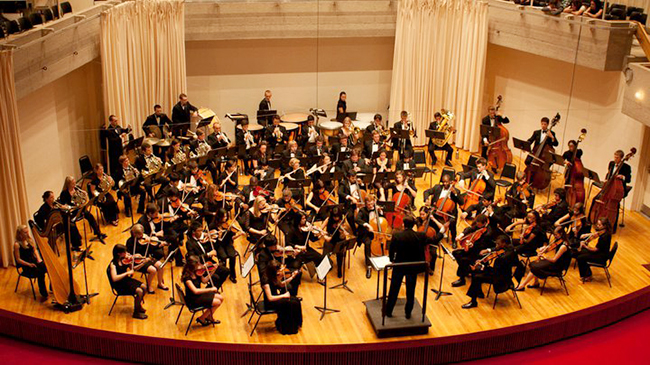

Once upon a time, classical music was considered cutting edge, a place for bold and brash experimentation. This past Saturday, the Amherst Symphony Orchestra brought one of those experiments to life with massive success. In a welcome concert for the class of 2020, the Symphony performed Antonin Dvorak’s Symphony #9, “From the New World” in E minor.
A bit of background on Dvorak and his Symphony: 1892, Dvorak and most of his family moved to New York City from his homeland in Bohemia after he was invited to direct the National Conservatory of Music. While he was living in America, he found himself fascinated by Native American and African American music, both of which eventually served as major inspirations for “From the New World.” Dvorak saw the adaptation of African American spirituals to be perfectly “respectable” enough for European audiences, considering how German folk songs and Moravian tunes had gotten the same exact treatment. He even went so far as to state that African American music would eventually be the bedrock of America’s musical future. When it debuted, “From the New World” was a hit success, with many considering it to be Dvorak’s finest accomplishment in an extremely distinguished career.
The first movement is a decidedly wonderful introduction to the piece, an electrifying start that immediately grabbed my attention with blaring horn blasts. As the movement progresses, it sinks into a softer and more soothing rhythm, settling the audience into the upcoming show. This is also the movement where the Symphony’s African American influences are most apparent, as I swear I caught a hint of “Swing Low, Sweet Chariot” somewhere along the line.
The second movement continues the mood with a soft sweet tune serving as something of a breather and making me think of relaxing in a nice open space in the countryside. After this little breather, the third movement throws the listener right back into the action, with an upbeat and energetic rhythm that would be right at home in some crazy chase scene out of a Disney movie. It also had the bearings of a folk song, calling back once again to the African American influences on the Symphony.
However, what really made an impact on me was the fourth and final movement. For starters, it was the sole movement that I had previously heard, though I couldn’t have named it if you had asked me. It was vaguely European, loud and boisterous, yet it also had its softer and more introspective moments. Massive bursts of energy and passion were mixed in with relaxation. I would say it was a pretty good summary of the “New World” we live in today, let alone the America of 100-odd years ago. It was a piece of music that definitely withstood the test of time.
While I had been told that Dvorak’s Symphony #9 was a very famous and very influential musical work, I had mostly just nodded along, because let’s be honest, most of us would have no idea if a symphony written more than a century ago would be considered influential, that is, until you listen to it. While sitting in the audience, I had a nagging feeling in the back of my mind while listening to the performance. Then it hit me. I had heard music like this before, in movies like “Star Wars,” “Jaws” and even “Lord of the Rings.” Perhaps the highest compliment that can be paid to any work of art is that it is still inspiring artists so many years down the line, artists that wind up writing music for some of the most iconic movies of all time.
Now, I’ll move on to the Amherst Symphony Orchestra itself. I have always had an admiration for orchestras. All of these people, these musicians with vastly different talents, come together and work as a unit to create a single work of art. The Amherst Symphony Orchestra is no different. Conducted by Mark Swanson, the orchestra worked collectively in concert to bring Dvorak’s work to life. I have nothing but respect and admiration for every single member of the orchestra, especially the first-years who stepped up for their first performance. It’s one thing to put on a welcome concert for the first-years, but another thing entirely to have them along to perform in it. The concert was a wonderful start to the year and an excellent welcome to Amherst’s class of 2020.